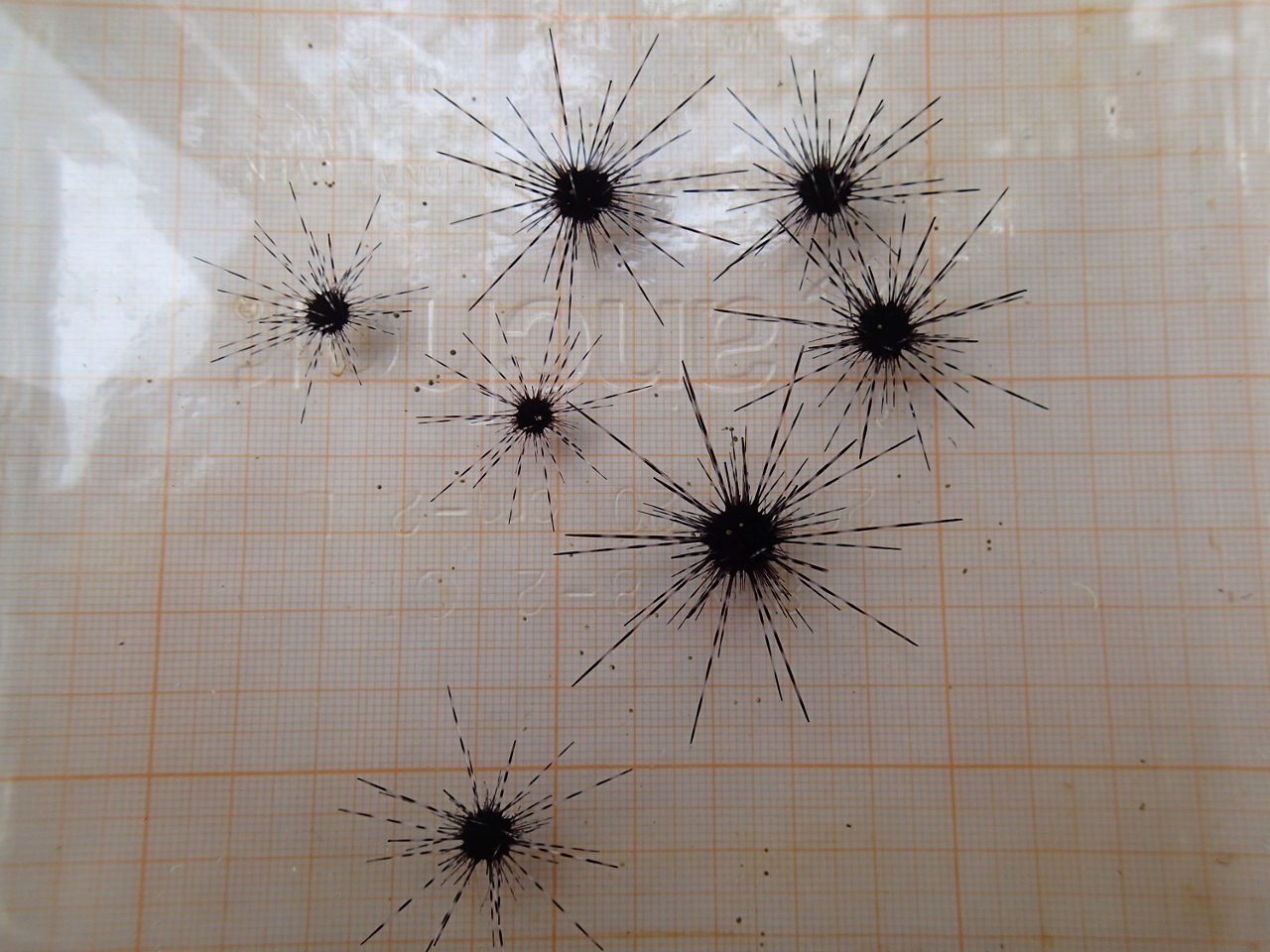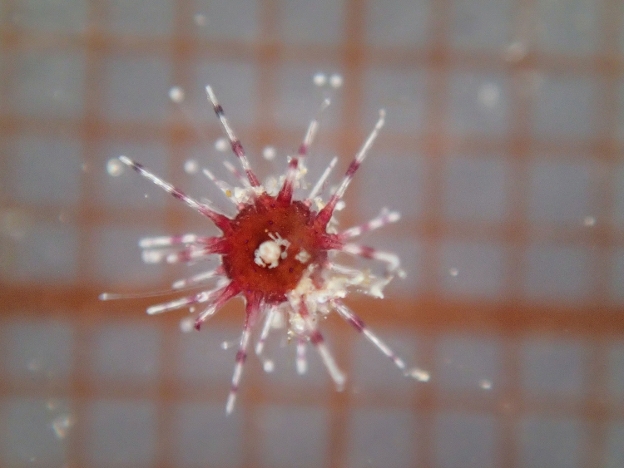Cookies
Van Hall Larenstein treats its customers' information with the utmost care and will never make this information available to third parties. Read more about us Privacy and Cookie Policy

The RAAK-PRO Diadema I project (2019 till 2024) aimed to restore the important herbivorous sea urchin Diadema antillarum on Caribbean coral reefs. The project finished in 2024 and this page provides a summary of the main project results. In the RAAK-PRO Diadema II project (2024-2027) we will continue working on developing methods to restore coral reefs through increased herbivory.
Contact principal investigator Alwin Hylkema ([email protected]) for more information or collaboration.
Project scope
The RAAK PRO Diadema project aimed to restore Diadema sea urchin populations (scientific name Diadema antillarum) on the coral reefs around Saba and St. Eustatius. Diadema sea urchins were the most important herbivores on Caribbean coral reefs. In 1983, more than 95% of the sea urchins died, due to an unknown disease. Without the grazing of the sea urchins, the algae increased in abundance, smothering adult corals and inhibiting the settlement of juvenile corals. As a result, the reef became covered with algae instead of corals. Nowadays, more than 35 years after the die-off, long spined sea urchins are still very rare. They are sometimes abundant in shallow waters, such as harbors, but are seldom seen on the deeper coral reef.
Worldwide coral reefs face many threats that are difficult to tackle locally, like global warming and ocean acidification. This makes it even more urgent to remove as much local threats as possible. Restoring the sea-urchin populations will remove the overgrowing algae and will make the reefs more resilient to the other threats they face. To do this, Van Hall Larenstein University of Applied Sciences (VHL), STENAPA, Saba Conservation Foundation, Wageningen Marine Research, Wageningen University, Caribbean Netherlands Science Institute, University of Applied Sciences HZ, ISER Caribe, Wortel Product Design and Golden Rock Dive Center worked together in the RAAK PRO Diadema project. VHL researcher Alwin Hylkema was principal investigator of the project. Other researchers in the project were Tom Wijers (VHL), Oliver Klokman (VHL), Dolfi Debrot (WUR) and many others from multiple partner institutes. The project was partly funded by the Dutch Organization for Scientific Research (NWO).
Project results
The project studied natural sea urchin settlement around Saba and St. Eustatius. A new settlement collector, made from bio balls, was developed: Hylkema, A., Debrot, A. O., Pistor, M., Postma, E., Williams, S. M., & Kitson-Walters, K. (2022). High peak settlement of Diadema antillarum on different artificial collectors in the Eastern Caribbean. Journal of Experimental Marine Biology and Ecology, 549, 151693.
Based on the high natural settlement a new method was developed to increase recruitment on the reef, which we termed Assisted Natural Recovery: Hylkema, A., Debrot, A. O., Van De Pas, E. E., Osinga, R., & Murk, A. J. (2022). Assisted natural recovery: A novel approach to enhance diadema antillarum recruitment. Frontiers in Marine Science, 9, 929355.
At the same time, a novel culture method was developed in collaboration with the University of Florida. For the first time in nearly 30 years, Diadema sea urchins could be produced with every single culture run. We named this new approach the shaker bottle method: Wijers, T., Hylkema, A., Pilnick, A. R., Murk, A. J., & Patterson, J. T. (2023). Novel shaker bottle cultivation method for the long spined sea urchin (Diadema antillarum; Philippi, 1845) results in high larval survival and settlement rates. Aquaculture, 562, 738855.
Because we could finally produce substantial amount of larvae, we were able to study the effect of different algae species on larvae settlement behavior: Wijers, T., van Herpen, B., Mattijssen, D., Murk, A.J., Patterson, J.T. & Hylkema, A. (2024) Implications of changing Caribbean coral reefs on Diadema antillarum larvae settlement. Marine Biology 171, 48.
We also worked on introducing Diadema sea urchins on the reef and studied their main predators: de Breuyn, M., van der Last, A. J., Klokman, O. J., & Hylkema, A. (2023). Diurnal predators of restocked lab-reared and wild Diadema antillarum near artificial reefs in Saba. PeerJ, 11, e16189.
In early 2022, Diadema sea urchins experienced a new mass mortality. Together with other regional experts the Diadema Response Network was established. Together we described signs of illness, mortality rates and spread throughout the Caribbean: Hylkema, A., Kitson-Walters, K., Kramer, P. R., Patterson, J. T., Roth, L., Sevier, M. L., ... & Lang, J. C. (2023). The 2022 Diadema antillarum die-off event: Comparisons with the 1983-1984 mass mortality. Frontiers in Marine Science, 9, 2654.
With a team of more than 40 researchers we were able to find the cause of the 2022 Diadema die-off. Results were published in Science Advances: Hewson, I., Ritchie, I. ., Evans, J. ., Altera, A., Behringer, D., Bowman, E., Brandt, M., Budd, K. ., Camacho, R. ., Cornwell, T. ., Countway, P. ., Croquer, A., Delgado, G. ., DeRito, C., Duermit-Moreau, E., Francis-Floyd, R., Gittens, S., Henderson, L., Hylkema, A., … Breitbart, M. (2023). A scuticociliate causes mass mortality of Diadema antillarum in the Caribbean Sea. Science Advances, 9(16).
The in the project developed methods are now used in multiple islands across the Caribbean. The great collaboration with practice and the substantial output were main reasons to award the project with the price for best applied research project of the Netherlands (the RAAK-award) in 2023: Read the article.
